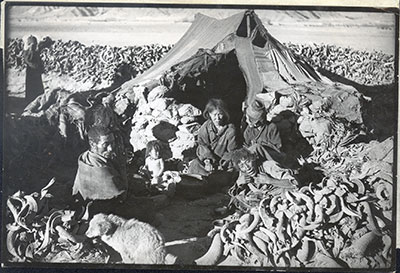
1998.131.234 (Print black & white)


1998.131.234 (Print black & white)

Frederick Spencer Chapman
Frederick Spencer Chapman
January 1937
Lhasa > Ragyapa camp
1998.131.234
117 x 173 mm
Print gelatin silver
Donated 1994
Faith Spencer Chapman
British Diplomatic Mission to Lhasa 1936-37
Frederick Spencer Chapman
8.13 [view film roll]
SC.T.2.234
Notes on print/mount - The caption 'Outcasts tent surrounded by horns from animals slaughtered' has been written across the back of the print in pencil. The caption 'An outcast's tent surrounded by a wall of bones from animals he has slaughtered' has been written on the tracing paper that has been attached to the back and folded over the front. There are also cropping instructions, which would result in the figure in the background being cropped from the scene. '8-7' has been written on the back in red crayon. Further reference numbers include '8-13' written on the middle of the back of the print in pencil and the Chatto & Windus publisher reference C&W41074/18. Chatto & Windus published Chapman's book of the Mission to Lhasa, Lhasa the Holy City in 1938. 25b has been written in the top left corner [MS 4/2/2005]
Manual Catalogues - Caption in Chapman's hand-written list of negatives made whilst on the Mission to Lhasa, 1936-7 [See PRM Manuscripts Collection]: 'Ragyapas - close ditto [general view tent and horn walls] dog in foreground'; PRM Manuscripts Collection: ‘List of Tibetan Prints and Negatives’ - Book 4: ‘16/2 - The Ragyapas or disposers of the dead and butchers with walls made of horns of slaughtered animals’ [MS 16/03/2006]
Other Information - Related Images: Images prefixed with '8.' comprise a group of negatives containing images of Mondo’s house, a weaver and ragyapa people. All these images seem to have been taken in January 1937 [MS 16/03/2006]
Other Information - Description: Chapman described encountering the dwellings of Ragyapa people in his book Lhasa the Holy City [London: Chatto & Windus 1938; reprint, London: Readers Union Ltd., 1940, pp.166-7]. He describes encountering a group when completing a circuit of the Linghkor pilgrimage route around Lhasa close to the Regent's summer palace: "On the left of the road are the hovels of the lowest class of Lhasa society, the ra-gyap-pa, a community of scavenging beggars whose work is to dispose of the dead bodies. ... // Their dwellings consist of a wall of sods into which are built the horns of animals; over the top is raised a roof of ragged yak-hair tent-cloth. This is often surrounded by an outer wall of the horns of yaks, cattle and sheep heaped together. In the summer their hovels are gay with nasturtiums and marigolds. ... But these are the lowest of the Ra-gyap-pa. Further on, though they must still live outside the city, they have proper houses, built of sun-dried bricks, but still with neat rows of yak horns let into the face of the wall, like a mosaic" [1940, pp. 166-7] [MS 21/3/2005]
For Citation use:
The Tibet Album.
"Ragyapa family outside tent shelter"
05 Dec. 2006. The Pitt Rivers Museum.
<http://tibet.prm.ox.ac.uk/photo_1998.131.234.html>.
For more information about photographic usage or to order prints, please visit the The Pitt Rivers Museum.
© The Pitt Rivers Museum